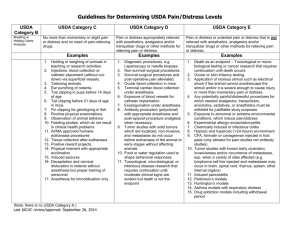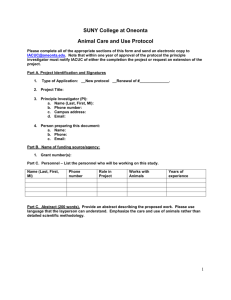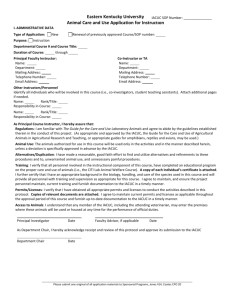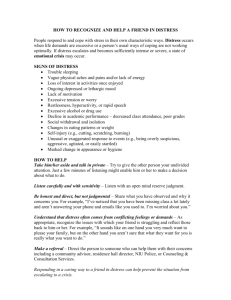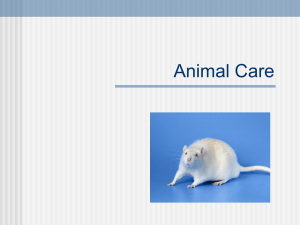Assigning Pain and Distress Levels to Animal Use Protocols
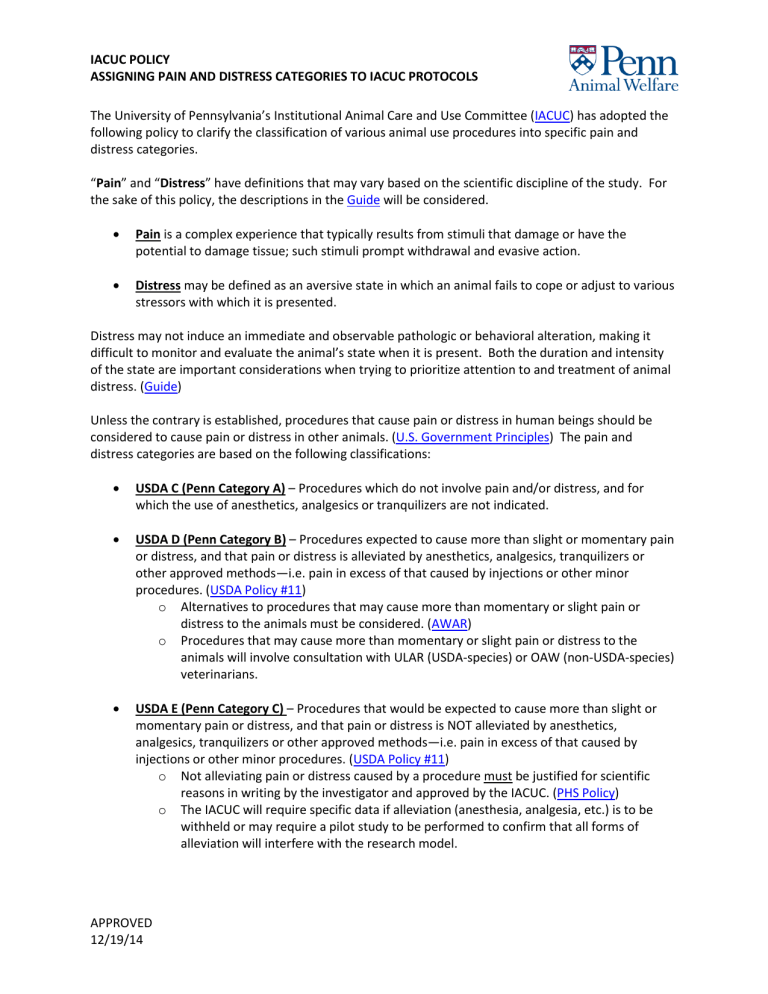
IACUC POLICY
ASSIGNING PAIN AND DISTRESS CATEGORIES TO IACUC PROTOCOLS
The University of Pennsylvania’s Institutional Animal Care and Use Committee ( IACUC ) has adopted the following policy to clarify the classification of various animal use procedures into specific pain and distress categories.
“ Pain ” and “ Distress ” have definitions that may vary based on the scientific discipline of the study. For the sake of this policy, the descriptions in the Guide will be considered.
Pain is a complex experience that typically results from stimuli that damage or have the potential to damage tissue; such stimuli prompt withdrawal and evasive action.
Distress may be defined as an aversive state in which an animal fails to cope or adjust to various stressors with which it is presented.
Distress may not induce an immediate and observable pathologic or behavioral alteration, making it difficult to monitor and evaluate the animal’s state when it is present. Both the duration and intensity of the state are important considerations when trying to prioritize attention to and treatment of animal distress. ( Guide )
Unless the contrary is established, procedures that cause pain or distress in human beings should be considered to cause pain or distress in other animals. ( U.S. Government Principles ) The pain and distress categories are based on the following classifications:
USDA C (Penn Category A) – Procedures which do not involve pain and/or distress, and for which the use of anesthetics, analgesics or tranquilizers are not indicated.
USDA D (Penn Category B) – Procedures expected to cause more than slight or momentary pain
or distress, and that pain or distress is alleviated by anesthetics, analgesics, tranquilizers or other approved methods—i.e. pain in excess of that caused by injections or other minor procedures. ( USDA Policy #11 ) o Alternatives to procedures that may cause more than momentary or slight pain or distress to the animals must be considered. ( AWAR ) o Procedures that may cause more than momentary or slight pain or distress to the animals will involve consultation with ULAR (USDA-species) or OAW (non-USDA-species) veterinarians.
USDA E (Penn Category C) – Procedures that would be expected to cause more than slight or momentary pain or distress, and that pain or distress is NOT alleviated by anesthetics, analgesics, tranquilizers or other approved methods—i.e. pain in excess of that caused by injections or other minor procedures. ( USDA Policy #11 ) o Not alleviating pain or distress caused by a procedure must be justified for scientific reasons in writing by the investigator and approved by the IACUC. ( PHS Policy ) o The IACUC will require specific data if alleviation (anesthesia, analgesia, etc.) is to be withheld or may require a pilot study to be performed to confirm that all forms of alleviation will interfere with the research model.
APPROVED
12/19/14
ASSIGNING PAIN AND DISTRESS CATEGORIES TO IACUC PROTOCOLS
All ARIES procedures are listed below in appropriate pain/distress categorizations.
Use of anesthesia alone does not necessitate a specific categorization. For short procedures that could be performed without anesthesia, but the individual elects to use anesthesia (e.g. restraint for tail vein blood collection in rodents, very precise injections, etc.), a USDA C (Penn A) categorization is appropriate. For long procedures, where anesthesia may prevent distress from awake prolonged restraint (e.g. long imaging procedures, etc.), a USDA D (Penn B) is appropriate. “Short” and “Long” timeframes may be defined differently based on the species, acclimation to the procedure, and the potential for pain or distress from the procedure itself.
If there are any questions about how to categorize a procedure that may not be included below, please contact the Office of Animal Welfare for assistance (215-898-2615 or iacuc@pobox.upenn.edu
).
Additionally, the IACUC guideline on “ Humane Intervention and Endpoints for Laboratory Animal
Species ” also contains useful information.
NOT APPLICABLE – Tissue Harvest and the Use of Core Facilities should not have a pain and distress category associated with the procedure. Tissue harvest is performed on a dead animal and the core facility and protocol will describe the specific procedures (and include the appropriate pain/distress category).
USDA C (Penn A) – Procedures which do not involve pain and/or distress, involve only very slight and momentary pain (e.g. needle stick), and for which the use of anesthetics, analgesics or tranquilizers are not indicated or required.
PROCEDURES
Animal Identification
CONDITIONS TO MINIMIZE PAIN/DISTRESS
Ear-tagging; ear-punching; microchipping; tattooing; toe-clipping rodents (only in mice aged 5-17 days).
Animal Models with Abnormal
Phenotypes
Models that do not elicit pain or distress, thus do not require any treatment or anticipate the need for humane euthanasia.
Behavioral Study Non-invasive and “low impact” studies:
Activity and observation
Open-field, mazes and other tests that allow animals to explore and move to preferred locations, conditioned place preference
Positive reward conditioning
Allodynia and hyperalgesia tests (e.g. von Frey, hot plate, tail flick)
Gait analysis
Strength and climbing tests
Rotorod and balance beams
Object recognition, marble burying
Running wheel
Food/fluid preference
2
ASSIGNING PAIN AND DISTRESS CATEGORIES TO IACUC PROTOCOLS
Blood/Fluid Collection
Euthanasia
Food Scheduling
Genetically Altered Animals
(Genotyping)
Imaging
Injection/Dosing
Lasers
Production of Monoclonal or Polyclonal
Antibodies
Prolonged Restraint
Radioactive Materials
Special Diets/Liquids
Special Housing and Husbandry
Other Procedure
Blood collection from peripheral vessels, collection of other fluids with mild/brief restraint.
By definition, euthanasia is “ending the life of an individual animal in a way that minimizes or eliminates pain and distress.” ( AVMA )
Caloric restriction, fasting for ≤24 in rodents, USDAcovered species must be given access to food for at least
1 hour at least once daily.
Collection of limited tissue sample from weanling rodents (up to 28 days of age), with the exception of toe clipping (see “Animal Identification” above).
Short-term procedures with conscious animals or prolonged procedures with anesthesia/sedation.
Injection or oral gavage of benign agents (saline, vehicle, antibiotics) or other dosing when there is no expectation of deleterious effects; see below in USDA D category for repeated injections/dosing.
Short-term exposure for conscious animals.
If no discomfort is anticipated; this procedure does NOT include ascites production models (see USDA E category).
If animals are acclimated to the device and the duration of restraint is less than 30 minutes.
Administration of radioactive materials should not induce pain or distress as a stand-alone procedure. If associated with a potentially painful or distressful procedure then see USDA D category below.
In most cases, provision of special food or medicated water should not induce pain or distress as a standalone procedure. If associated with a potentially painful or distressful procedure (e.g. tumor production, DSSinduced colitis, etc.) then see USDA D category below .
Variations on standard housing modalities that should not lead to stress/distress.
NOTE: For any potentially painful or distressful procedures the “Non-Surgical Procedures with
Potential for Pain or Distress” Procedure should be selected.
USDA D (Penn B) – Procedures that would be expected to cause more than slight or momentary pain or distress that is appropriately alleviated by anesthetics, analgesics, tranquilizers, removal from study, euthanasia, or other approved methods. This category implies that the “pain” is in excess of that caused by injections or other minor procedures ( USDA Policy #11 ).
3
ASSIGNING PAIN AND DISTRESS CATEGORIES TO IACUC PROTOCOLS
PROCEDURES
Animal Models with Abnormal
Phenotypes
Behavioral Study
Treadmill and forced exercise
Morris water maze
Fear conditioning (foot shock)
Chronic variable stress (constant bedding changes, cage manipulations, exposure to predator scents, absence or abundance of enrichments)
Self-administration and extinction of drugs in addiction models
Novelty-induced hypophagia
Blood/Fluid Collection
Any collection procedure in rodents requiring anesthesia (e.g. cardiac, CSF tap, cut-down, and retro-orbital blood access)
Food Scheduling >24 hours
Genetically Altered Animals
(Genotyping) – tail biopsy on rodents >
28 days old
Injection/Dosing
Intranasal inoculations in rodents
Footpad injections in rodents
Retro-orbital injections in rodents
Injection of compounds, like vaccinations, toxins or adjuvants
[excluding Complete Freund’s
Adjuvant (CFA)] that may be irritating or may cause local or generalized inflammation
Repeat injections
Irradiation
ALLEVIATION FOR PAIN/DISTRESS
Appropriate treatment or euthanasia when humane endpoint is reached.
If pain, agitation, and/or distress are noted, then animals are at least removed from the test/study, then treated (if applicable).
Local anesthetic to general anesthesia, as applicable.
Remove animal from study, provide feed, and/or euthanize.
General anesthesia (e.g. isoflurane).
Anesthesia, if required to reduce distress from administering compounds to awake animals, or additional treatments (including analgesia) if postprocedure care is anticipated.
Necessitating increased monitoring of injection sites and overall health with potential removal from study.
Lasers
Non-Surgical Procedures with Potential for Pain or Distress
Production of Monoclonal or Polyclonal
Antibodies
Prolonged Restraint
Appropriate monitoring and supportive care expected, humane endpoints should be described .
Anesthesia, if required to reduce distress from awake prolonged restraint.
Anesthesia, analgesia, other appropriate treatment or euthanasia when humane endpoint is reached.
Necessitating blood collection; excluding ascites development and excluding CFA (see below).
If not acclimated, if longer than 30 minutes, or if animals are removed from the device, then treated (if applicable) if agitation and/or distress are noted.
4
ASSIGNING PAIN AND DISTRESS CATEGORIES TO IACUC PROTOCOLS
Radioactive Materials
Special Diets/Liquids
Special Housing and Husbandry
Constant light for nocturnal species
Constant darkness for diurnal species
Hypoxia, hyperoxia, hypercapnia
Prolonged heat or cold exposure
No contact bedding or nesting material (mice)
Survival Surgery
Terminal Surgery
Tumor Production
Dose or duration-associated adverse effects that are relieved with supportive care or removal from the study
(or euthanasia).
If associated with a potentially painful or distressful procedure (e.g. tumor production, DSS-induced colitis, etc.) and additional treatments (including analgesia) to alleviate distress.
Appropriate and frequent monitoring and humane endpoints are in place to provide alleviation that is specific to the protocol (i.e. nestlets provided to mice undergoing cold exposure if unable to thermoregulate).
Water Scheduling
Anesthesia, pre-op analgesia, and post-op analgesia
Anesthesia +/- pre-op analgesia
Appropriate treatment when specific clinical signs are observed or euthanasia when humane endpoint is reached; ascites production <=120% baseline weight and not requiring abdominal taps
Provision of additional water or parenteral fluids with signs of dehydration or otherwise indicated.
USDA E (Penn C) – Procedures that would be expected to cause more than slight or momentary pain or distress NOT alleviated by anesthetics, analgesics, tranquilizers or other approved methods, i.e. pain in excess of that caused by injections or other minor procedures ( USDA Policy #11 ).
It is important to remember that the IACUC approval of a procedure’s categorization as USDA E (Penn C) does not imply or infer that those animals may be maintained indefinitely or with a condition that is not specifically described and justified in the procedure. Animals may only be maintained under USDA E
(Penn C) conditions while being appropriately monitored for the specific humane endpoints described within the protocol and for no longer than the precise time approved in the protocol. If an animal reaches the endpoint criteria prior to the specified maximum allowed duration, they must be removed from study, appropriately treated, or euthanized. Extending any time point or adding clinical signs to a condition will require additional IACUC approval of a protocol amendment.
Please note that the selection of “Injection/Dosing” procedure is not appropriate for a Category E protocol. If one will be injecting a substance that will have a known deleterious effect on the animal, then “Non-Surgical Procedure with Potential for Pain/Distress” should be chosen to provide better humane endpoints and description of level of morbidity/mortality that is anticipated with the model.
5
ASSIGNING PAIN AND DISTRESS CATEGORIES TO IACUC PROTOCOLS
PROCEDURES
Animal Models with Abnormal
Phenotypes
Behavioral study
Forced aggression (e.g. intruder, social defeat)
Sleep deprivation (>24 hours)
Depression tests (e.g. forced swim, tail suspension, learned helplessness)
Inescapable foot shock
Untreated withdrawal from induced addiction
Irradiation – lethal
-
Non-Surgical Procedures with
Potential for Pain or Distress
Production of Monoclonal or
Polyclonal Antibodies
Tumor Production
Special Housing and Husbandry
Constant light for nocturnal species
Constant darkness for diurnal species
Hypoxia, hyperoxia, hypercapnia
Prolonged heat or cold exposure
Survival Surgery
JUSTIFICATION
Endpoints of the model require a painful , distressful, or moribund condition for a scientifically justified period of time
Tests that require inducing pain or distress.
Endpoints of the model require a painful, distressful, or moribund condition for a scientifically justified period of time.
Endpoints of the model require a painful, distressful, or moribund condition for a scientifically justified period of time.
For example, injecting substances at doses that are known to cause deleterious effects (LPS, injecting a toxin, adjuvant, etc).
Ascites production models requiring abdomen taps to relieve ascites accumulation, use of CFA for antibody production.
Husbandry conditions that may precipitate pain/distress for a scientifically justified period of time with no alleviation of signs.
Post-op analgesia withheld if it will interfere with the model and is scientifically justified. (Note: surgical plane of anesthesia always required).
Ascites production models exceeding 120% baseline weight or requiring abdomen taps to relieve ascites accumulation
6
